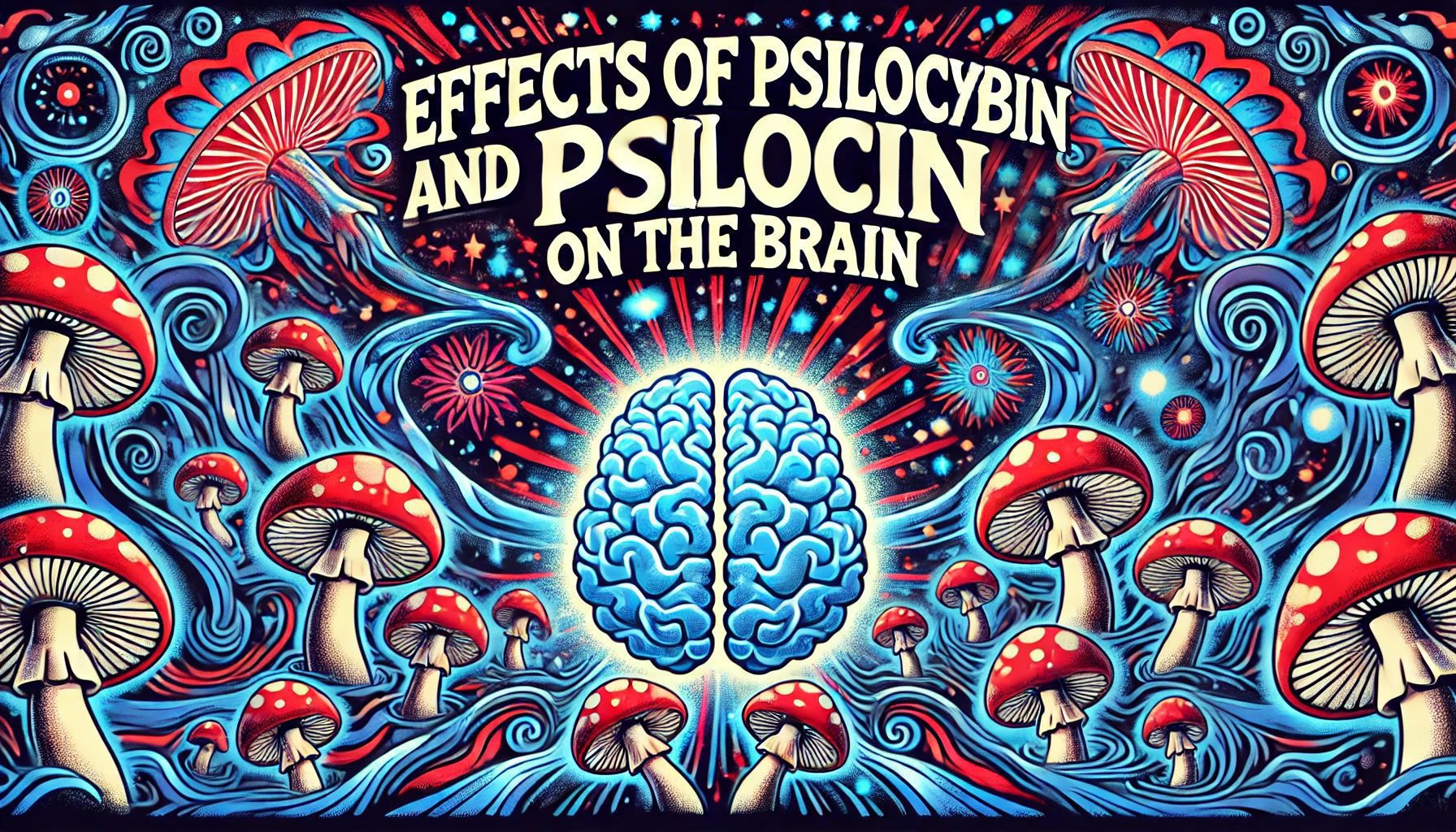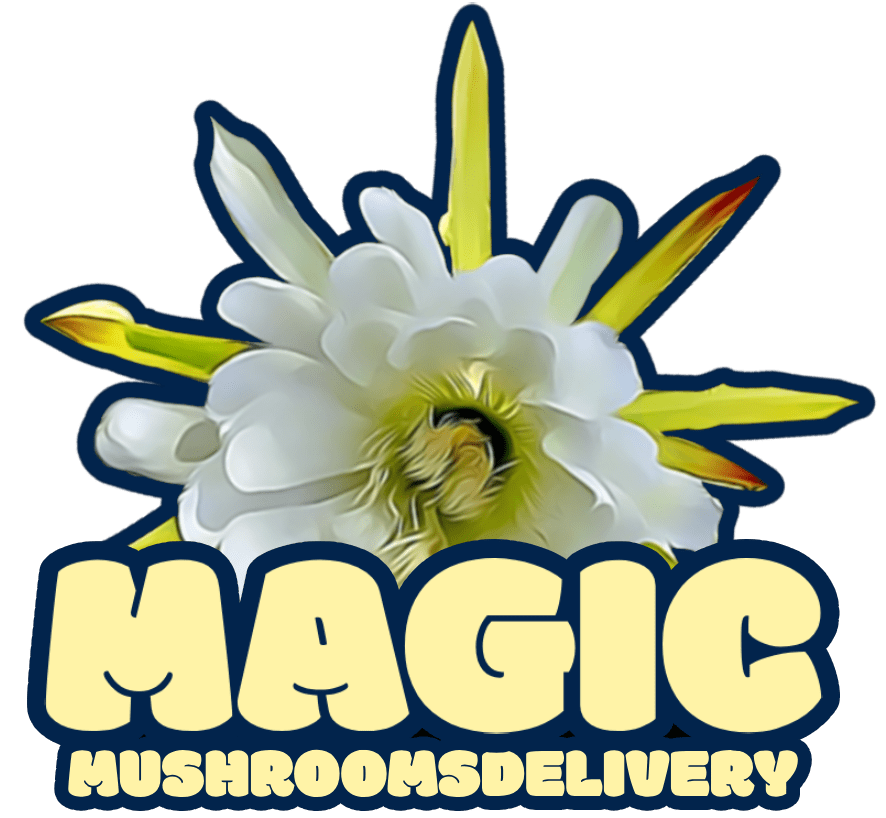

Effects of Psilocybin and Psilocin on the Brain
Psilocybin and its active metabolite, psilocin, have captivated, well, everyone at this point. The public is also intrigued by their profound effects on human consciousness. These compounds offer potential therapeutic applications. These compounds are found naturally in certain mushroom species, colloquially known as magic mushrooms. They have been used for centuries in traditional practices. Now, these compounds are at the forefront of modern neuroscientific research.
The journey of psilocybin begins with its natural occurrence. It has become a subject of intense scientific scrutiny. This is a testament to the evolving landscape of neuroscience and psychopharmacology. As we explore the effects of these substances on the brain, we gain new insights into consciousness. We consider the implications for cognition and emotional processing. This article will give a broad perspective on the current knowledge of how psilocybin and psilocin affect brain function. It covers everything from the molecular level to large-scale network dynamics.
What are the effects of psilocybin on the brain?
- Psilocybin is rapidly converted to psilocin in the body, which is the primary active compound.
- Psilocin primarily acts on serotonin 2A receptors in the brain.
- Effects include altered neurotransmitter release, increased brain connectivity, and enhanced neuroplasticity.
- Psilocybin modulates the Default Mode Network, potentially leading to altered self-perception.
- Cognitive flexibility and emotional processing are significantly impacted.
- Sensory perception can be enhanced, even at low doses.
- Research suggests potential therapeutic applications for mental health disorders.
- The effects of psilocybin are complex and multifaceted, influencing various brain functions.
What Happens Why Psilocybin Enters the Body?
When psilocybin enters the body, it’s quickly converted to psilocin, which then crosses the blood-brain barrier. This process is crucial for understanding the effects of “magic mushrooms,” as it is psilocin that actually interacts with the brain’s neurotransmitter systems. Once in the brain, psilocin primarily acts on serotonin 2A receptors (5-HT2A), triggering a cascade of neurological effects that ripple through various brain systems and networks.
The interaction between psilocin and 5-HT2A receptors is just the beginning of a complex series of events that ultimately lead to the profound cognitive, emotional, and perceptual changes associated with psilocybin use. These effects can range from subtle alterations in mood and cognition at low doses to profound shifts in consciousness and perception at higher doses. Let’s explore these effects in detail:
Neurotransmitter Release
The impact of psilocin on neurotransmitter systems extends beyond its direct action on serotonin receptors. This compound initiates a domino effect that influences multiple neurotransmitter systems, creating a symphony of chemical changes in the brain.
- Glutamate Release:
- Psilocin stimulates increased glutamate release in the prefrontal cortex, a region crucial for executive functions and higher-order thinking.
- Glutamate, as the brain’s primary excitatory neurotransmitter, plays a vital role in learning, memory, and synaptic plasticity.
- The surge in glutamate may contribute to the enhanced cognitive flexibility and altered thought patterns often reported by psilocybin users.
- This glutamate modulation is also thought to play a significant role in the compound’s potential antidepressant effects, possibly by promoting neuroplasticity and forming new neural connections.
- Dopamine Modulation:
- While psilocin doesn’t directly activate dopamine receptors, it indirectly influences dopamine systems through complex neural pathways.
- This modulation of the dopamine system may contribute to the feelings of euphoria and the sense of novelty or importance often attributed to thoughts and perceptions under the influence of psilocybin.
- Changes in dopamine activity might explain the reported improvements in motivation and focus that some individuals experience during microdosing regimens.
- The interaction with the dopamine system also highlights the potential risk of psilocybin use for individuals with dopamine-related disorders, emphasizing the need for careful medical supervision in therapeutic contexts.
- Effects on Other Neurotransmitters:
- There’s growing evidence of psilocin’s effects on norepinephrine, which could influence alertness, attention, and the body’s stress response.
- GABA systems may also be affected, potentially contributing to the anxiolytic (anti-anxiety) effects reported by some users. This interaction with GABA might explain the sense of relaxation and decreased anxiety that can occur, especially at lower doses.
- The broad impact on multiple neurotransmitter systems underscores the complex pharmacology of psilocybin and helps explain the wide range of effects experienced by users.
Brain Network Connectivity
One of the most fascinating aspects of psilocybin’s effects on the brain is its ability to alter the connectivity between different brain regions. This reshaping of neural communication patterns may underlie many of the compound’s cognitive and perceptual effects.
- Enhanced Communication:
- Psilocin appears to increase communication between brain regions that don’t typically interact strongly under normal conditions.
- This enhanced cross-talk between usually distinct brain networks may lead to the formation of novel associations and thought patterns, potentially explaining the enhanced creativity and “out-of-the-box” thinking reported by many users.
- The breaking down of typical brain network boundaries may also contribute to the sense of unity and interconnectedness often described in psilocybin experiences.
- Global Brain Connectivity:
- Neuroimaging studies show increased global brain connectivity under the influence of psilocybin, suggesting a state of heightened integration across the entire brain.
- This heightened whole-brain connectivity may allow for more flexible thinking and novel problem-solving approaches, as information is shared more freely across diverse brain regions.
- The increase in global connectivity might also explain the intensified emotional responses and the ability to access and process deeply held memories or emotions.
- “Reset” of Brain Circuits:
- Some researchers propose that psilocybin may temporarily disrupt and then “reset” certain brain circuits, particularly those involved in mood regulation and cognitive processing.
- This neurological “shake-up” could potentially help break negative thought patterns in conditions like depression, offering a fresh start for more adaptive neural configurations.
- The reset phenomenon might explain why some individuals report long-lasting positive changes in mood and outlook following a single high-dose psilocybin session.
Neuroplasticity
Perhaps one of the most promising aspects of psilocybin’s effects on the brain is its potential to enhance neuroplasticity – the brain’s ability to form new neural connections and reorganize existing ones.
- Neurogenesis:
- Animal studies suggest psilocybin may promote the formation of new neurons, particularly in the hippocampus, a region crucial for learning and memory.
- This pro-neurogenic effect could have profound implications for treating conditions characterized by decreased neurogenesis, such as depression and age-related cognitive decline.
- The stimulation of neurogenesis might contribute to the long-term positive effects reported by some individuals long after the acute effects of psilocybin have worn off.
- Synaptogenesis:
- Psilocybin appears to increase the formation of new synapses, the connections between neurons that allow for information transfer.
- Enhanced synaptogenesis could contribute to improved cognitive function and emotional processing by literally creating new pathways for neural communication.
- This increase in synaptic connections may underlie the reported enhancements in learning and the ability to break free from rigid thinking patterns.
- Dendritic Spine Growth:
- Research indicates psilocybin may promote the growth of dendritic spines, small protrusions on neurons that receive signals from other neurons.
- Increased dendritic spine density is associated with enhanced neural plasticity and learning capacity.
- The growth of new dendritic spines could provide a structural basis for the formation of new memories and the integration of new experiences, potentially explaining the profound and often transformative nature of psilocybin experiences.
Default Mode Network (DMN) Modulation
The Default Mode Network (DMN) is a set of interconnected brain regions that are active when we’re at rest and engaged in self-referential thinking. Psilocybin’s effect on the DMN is one of its most intriguing and potentially therapeutic aspects.
- Decreased DMN Activity:
- Psilocybin significantly reduces activity in the Default Mode Network, which is typically associated with self-referential thinking, mind-wandering, and rumination.
- This dampening of DMN activity may explain the sense of expanded awareness and the dissolution of ego boundaries often reported in psilocybin experiences.
- Reduced DMN activity might be particularly beneficial in conditions like depression, where overactivity of this network is associated with negative self-focus and rumination.
- “Ego Dissolution”:
- At higher doses, the suppression of DMN activity can lead to a phenomenon known as “ego dissolution” or “ego death.”
- This experience involves a reduced sense of self and blurred boundaries between self and environment, often described as a feeling of oneness with the universe.
- While potentially unsettling, this experience of ego dissolution is often reported as profoundly meaningful and transformative by users.
- Altered Self-Perception:
- Even at lower doses, changes in DMN activity may contribute to subtle shifts in self-perception and introspection.
- This could explain reports of increased self-awareness and personal insights during microdosing regimens.
- The ability to step back from one’s usual patterns of self-referential thinking may allow for new perspectives on personal issues and behaviors.
Cognitive Flexibility
One of the most consistently reported effects of psilocybin is enhanced cognitive flexibility – the ability to adapt one’s thinking and behavior in response to changing environments or requirements.
- Enhanced Divergent Thinking:
- Psilocybin appears to enhance divergent thinking, the ability to generate multiple solutions to a problem.
- This effect may underlie reported increases in creativity and novel idea generation, as users find themselves able to make unexpected connections and think beyond conventional boundaries.
- Enhanced divergent thinking could have applications in fields requiring innovation and creative problem-solving.
- Improved Problem-Solving:
- Some studies suggest psilocybin can enhance problem-solving abilities, particularly for complex, abstract problems.
- This improvement may be due to the increased brain connectivity and cognitive flexibility induced by the compound, allowing for more holistic and novel approaches to challenges.
- The enhanced problem-solving capability might explain why some Silicon Valley professionals have experimented with microdosing for work performance.
- Novel Perspectives:
- Users often report gaining new perspectives on personal issues or long-standing problems.
- This could be a result of the altered brain connectivity and reduced rigidity in thinking patterns, allowing individuals to break free from habitual thought processes.
- The ability to see things from new angles may contribute to the therapeutic potential of psilocybin in conditions like addiction, where breaking out of entrenched patterns of thinking is crucial.
Emotional Processing
Psilocybin’s effects on emotional processing are complex and multifaceted, influencing how we perceive, experience, and regulate emotions.
- Amygdala Reactivity:
- Psilocybin appears to alter the reactivity of the amygdala, a key region in emotional processing and the fear response.
- This modulation of amygdala activity may contribute to changes in emotional responses and increased emotional awareness.
- The altered amygdala reactivity might explain the potential of psilocybin in treating anxiety disorders and PTSD, where hyperactivity of the amygdala is often observed.
- Emotional Resilience:
- Some research suggests psilocybin may enhance emotional resilience, possibly by altering how the brain processes negative stimuli.
- This could explain reports of improved mood and reduced anxiety in some users, even well after the acute effects of the drug have worn off.
- Enhanced emotional resilience might contribute to the potential efficacy of psilocybin in treating mood disorders like depression.
- Empathy and Openness:
- Studies have found increases in traits like empathy and openness following psilocybin use.
- These changes may persist beyond the acute effects of the drug, suggesting potential long-term impacts on personality.
- Increased empathy and openness could have significant implications for personal relationships and social interactions, potentially contributing to improved interpersonal functioning.
Sensory Processing
Psilocybin is well-known for its ability to alter sensory perception, an effect that occurs even at relatively low doses.
- Enhanced Perception:
- Psilocybin can enhance sensory perception, making colors seem brighter, sounds more distinct, and textures more noticeable.
- Even at microdose levels, some users report heightened sensory appreciation, suggesting that this effect occurs along a continuum of dosage.
- This enhancement of sensory input might contribute to the reported feelings of awe and wonder often associated with psilocybin experiences.
- Potential for Synesthesia:
- At higher doses, psilocybin can induce synesthesia, a blending of senses where, for example, users might “see” music or “taste” colors.
- While this effect is less common with microdosing, it illustrates the compound’s powerful effects on sensory processing and integration.
- The occurrence of synesthesia highlights psilocybin’s ability to break down normal boundaries in brain function, allowing for novel sensory experiences.
- Altered Time Perception:
- Changes in time perception are common with psilocybin use, even at lower doses.
- Users often report a slowing or dilation of subjective time, which may be related to altered activity in brain regions involved in temporal processing.
- This alteration in time perception might contribute to the sense of profundity and expanded awareness often reported in psilocybin experiences.
The Promise of Psilocybin Research
The complex effects of psilocybin on the brain have sparked intense interest in its potential therapeutic applications. A groundbreaking psilocybin-assisted treatment for major depressive disorder study found that psilocybin, when combined with psychotherapy, produced rapid and substantial antidepressant effects in patients with treatment-resistant depression. This research underscores the potential of psilocybin as a novel treatment for mental health disorders that have proven difficult to treat with conventional methods.
The study’s findings are particularly significant given the challenges posed by treatment-resistant depression. Participants who received psilocybin-assisted therapy showed marked improvements in depressive symptoms, with effects lasting well beyond the acute drug experience. This suggests that psilocybin may offer a new paradigm in mental health treatment, one that could provide relief for individuals who have not responded to traditional antidepressants.
Moreover, a comprehensive review exploring psychedelics and neuroplasticity highlighted the potential of psychedelics, including psilocybin, to “rewire” the brain and treat various neuropsychiatric conditions. This review synthesized evidence from both animal and human studies, providing a robust scientific basis for the neuroplastic effects of psychedelics.
The review’s findings suggest that psychedelics like psilocybin may promote structural and functional neuroplasticity, potentially counteracting the loss of synaptic connections often seen in conditions like depression and addiction. This neuroplastic effect could explain the long-lasting benefits observed in some studies, where a single or few doses of psilocybin led to sustained improvements in mood and behavior.
These findings open up exciting possibilities for the future of mental health treatment. The ability of psilocybin to potentially “reset” brain circuits and promote neuroplasticity could lead to new treatment approaches for a wide range of neuropsychiatric conditions, including but not limited to depression, anxiety disorders, addiction, and PTSD.
Wrapping It Up
The effects of psilocybin and psilocin on the brain are multifaceted and profound, influencing everything from neurotransmitter release to cognitive flexibility and emotional processing. As we’ve explored, these compounds have the potential to alter brain network connectivity, enhance neuroplasticity, modulate the Default Mode Network, and significantly impact cognitive and emotional processes.
While much of the current research focuses on larger doses in controlled therapeutic settings, the growing interest in microdosing highlights the need for further investigation into the subtle, sub-perceptual effects of these compounds. The potential for psilocybin to enhance creativity, problem-solving abilities, and emotional resilience even at low doses presents intriguing possibilities for cognitive enhancement and mental health maintenance.
As research continues, we may uncover even more about how these fascinating substances interact with our brains and their potential to revolutionize our understanding of consciousness and mental health treatment. The studies on psilocybin-assisted therapy for depression and the exploration of psychedelics’ effects on neuroplasticity are just the beginning. These lines of research could lead to new treatment paradigms for a range of mental health conditions, potentially offering hope to individuals who have not responded to traditional therapies.
However, it’s crucial to remember that while the potential benefits are exciting, psilocybin remains a powerful compound that should be approached with caution and respect. The complexity of its effects on the brain underscores the need for careful, controlled research and regulated use. The experiences induced by psilocybin can be profound and transformative, but they can also be challenging and potentially destabilizing without proper support and guidance.
The journey of discovery in psychedelic research is just beginning, and the effects of psilocybin and psilocin on the brain promise to be a rich area of study for years to come. As we continue to unravel the mysteries of these compounds, we may gain not only new therapeutic tools but also deeper insights into the nature of consciousness, perception, and the remarkable plasticity of the human brain.
Looking ahead, the field of psychedelic research stands at an exciting frontier. The potential applications extend beyond mental health, possibly informing our approaches to creativity, problem-solving, and even our understanding of human consciousness itself. As we move forward, it will be crucial to balance scientific rigor with open-mindedness, carefully examining both the benefits and risks of these powerful compounds.
Ultimately, the story of psilocybin and psilocin is not just about a single compound or treatment approach. It’s a window into the vast complexities of the human brain and the myriad ways in which our neural chemistry shapes our experience of the world. As we continue to explore and understand these effects, we may find ourselves on the cusp of a new era in neuroscience and mental health treatment – one that recognizes the profound interconnectedness of brain, mind, and consciousness.
Tommy Lee
Table of Contents
Canada’s Mushroom Dispensary
Calgary
We deliver magic mushrooms same day in Calgary. Enjoy quick delivery within 60 minutes anywhere within city limits between 10am and 9pm daily.
Canada
Canada's magic mushroom delivery service. We bring shrooms to your place in 1 - 4 days depending where you are in Canada. Shrooms near me? We have you covered.
Be first on the list to get notified about our sales, new genetics and drops before they sell out!

